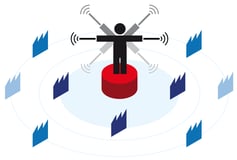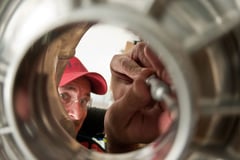4 Reasons for a Parts-Oriented Supply Chain
Nick Ostdick - October 13, 2016

 Ask any OEM or automotive supplier about the automotive supply chain of today versus ten years ago and you’ll probably hear the same thing: The world has changed. So much is new, so much is different.
Ask any OEM or automotive supplier about the automotive supply chain of today versus ten years ago and you’ll probably hear the same thing: The world has changed. So much is new, so much is different.
Movements toward globalization and individualization - both supported by rapid advances in technology - have made it possible for larger production networks to span multiple continents and regions. Adding complexity comes from wide variances within the production stream in order to meet customer demand for variety and choice. Whereas ten years ago component parts were often sourced within close proximity to suppliers, today parts travel from disparate parts of the globe, which has resulted in great opportunities and challenges for the players in today’s automotive supply stream.
While the opportunities are perhaps more easily understood - enhanced production processes, emerging customer pools and markets, and new partnerships with suppliers, manufacturers, and distributors - the challenges are perhaps less realized.
Stability, transparency, and E2E visibility have in some sense become victims as the supply chain continues to develop on a global level with longer lead times, greater complexity and variation in production programs, and the movement of component parts across greater distances under tight delivery timetables.
As such, the movement toward a parts-oriented supply chain where the sales-oriented scheduling of orders and material scheduling strategies are merged into one function is allowing OEMs to operate with greater levels of visibility and agility. The merger of these two organizational functions allows manufacturers to achieve greater insight into the overall supply situation to leverage lean principles which result in enhanced productivity and growth across a company’s entire value chain.
To further understand this development in global supply chain management, here are 4 reasons why a parts-oriented supply chain is a core driver in how the automotive industry should operate in the 21st century.
1). A parts-oriented supply chain allows OEMs to identify and correct shortages or overages. Without the precise coordination that accompanies the merger of sales and material scheduling in a parts-oriented supply chain, shortages are often discovered at later stages of the supply pipeline which does not allow much maneuverability for OEMs to modify and adjust inventory. However, given the enhanced visibility gain by combining sales and material scheduling, OEMs can not only recognize potential shortages or missing inventory, but they can make decisions at the planning and production levels to ensure the right parts are at the right place at the right time for production programs.
This is critical because OEMs in today’s automotive supply stream are increasingly becoming more and more responsible for optimizing supply chains to ensure parts are delivered on schedule.
2). OEMs can better manage and reduce freight management and shipping costs. Because a parts-oriented supply chain creates a clearer picture of the supply situation at multiple levels across a company’s value chain, more cost-effective decisions can be leveraged when it comes to freight and shipping. Checks on part coverage, inventory, and yard and dock management create value-added propositions for OEMs in deciding when to utilize certain transportation strategies - LTL (Less than Load), container pull solutions, and container load management - to enhance reliability of delivery in ways that promote both reductions in cost and increases in customer satisfaction.
For example, a parts-oriented supply chain model allows planners and managers to schedule, track, and monitor a shipment of parts from one continent to the other with the agility necessary to adjust part levels should the parameters of production change during transit, as is the case all too often in the modern supply stream.
3). Better ‘What-if’ simulations and planning. Imagine, just for a moment, a container is lost or severely damaged during transit, essentially wiping out an entire order or multiple orders in the blink of an eye. How does an OEM recover from such a loss? What measures can and should be taken to ensure part coverage, inventory stability, and the ability to move reserve stock into the supply stream to replace the lost or damaged parts? Because a parts-oriented supply chain is all about greater visibility and maneuverability, planners and managers can deploy powerful, integrated simulations and what-if scenarios based on a more holistic view of the supply situation to create more accurate demand planning.
As a result, thinking back to our example, an OEM can determine which days of production and orders were impacted by the lost container and the steps necessary to provide complete coverage.
4). Bottlenecks? What bottlenecks? In large due to the previous three benefits or facets of a parts-oriented supply chain, OEMs are better equipped to avoid one of the most dreaded scenarios in global supply chain management: the bottleneck. The capacity to recognize and adjust to potential shortages, leverage more effective shipping and freight decisions, and conduct detailed simulations and forecasting provide OEMs with enough supply chain firepower to avoid or respond to bottlenecks in efficient, cost-effective fashion.
As opposed to the supply chain of ten years ago when bottlenecks in production weren’t often identified until it was too late - meaning at later, more damaging points in the stream pipeline - today’s parts-oriented supply chain allows planners and managers to get out in front of bottlenecks and create accurate planning and production programs to avoid them entirely.
LATEST POSTS
- Understand Circular Economy in The Manufacturing Industry
- How Can Industry 4.0 IT Integration Be Achieved Smoothly?
- The Significance of Order Sequencing in Discrete Manufacturing
- How to improve your Supply Chain Management: The Power of Control Towers
- Optimizing Human Resource Scheduling in Manufacturing: A Technological Approach



